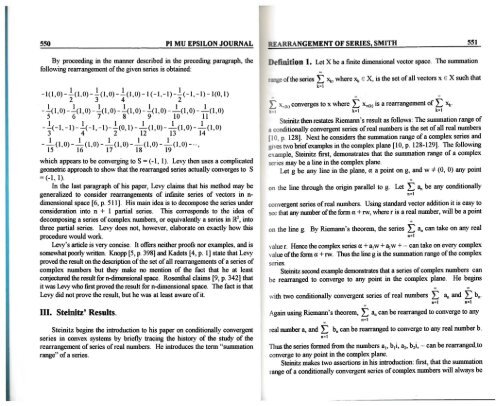Vol. 10 No 7 - Pi Mu Epsilon
Vol. 10 No 7 - Pi Mu Epsilon
Vol. 10 No 7 - Pi Mu Epsilon
You also want an ePaper? Increase the reach of your titles
YUMPU automatically turns print PDFs into web optimized ePapers that Google loves.
550 PI MU EPSILON JOURNAL<br />
By proceeding in the manner described in the preceding paragraph, the<br />
follo\ving rearrangement of the given series is obtained:<br />
1 1 1 l<br />
-1 (l '0)-2 ( 1. 0)-3 (l' 0)-4 ( 1 '0)- 1 ( -1.-1) -2 (-I' -1)- 1(0, 1)<br />
- _!_( l , 0) - _!_( 1, 0) - _!_( 1 , 0) - _!_( 1, 0) - _!_( 1 , 0) - _I (1 , 0) - - 1 ( 1, 0)<br />
5 6 7 8 9 <strong>10</strong> 11<br />
l 1 l l 1 1<br />
-3( -1, -1)- 4( -1, -1)- 2(0, 1) -12(1,0) -13(1,0) -14(1,0)<br />
1 I l I l<br />
-15(1,0)-16(1,0) -17(1,0) -18(1,0) -19(1,0)- ···,<br />
which appears to be converging to S = (-1, 1). Levy then uses a complicated<br />
geometric approach to show that the rearranged series actually converges to S<br />
= (-1, 1).<br />
In the last paragraph of his paper, Levy claims that his method may be<br />
generalized to consider rearrangements of infinite series of vectors in n<br />
dimensional space [6, p. 511]. His main idea is to decompose the series under<br />
consideration into n + 1 partial series. This corresponds to the idea of<br />
decomposing a series of complex numbers, or equivalently a series in R 2 , into<br />
three partial series. Levy does not, however, elaborate on exactly how this<br />
procedure would work.<br />
Levy's article is very concise. It offers neither proofs nor examples, and is<br />
somewhat poorly written. Knopp [5, p. 398] and Kadets [4, p. 1] state that Levy<br />
proved the result on the description of the set of all rearrangements of a series of<br />
complex numbers but they make no mention of the fact that he at least<br />
conjectured the result for n-dimensional space. Rosenthal claims [9, p. 342] that<br />
it was Levy who first proved the result for n-dimensional space. The fact is that<br />
Levy did not prove the result, but he was at least aware of it.<br />
III. Steinitz' Results.<br />
Steinitz begins the introduction to his paper on conditionally convergent<br />
series in convex systems by briefly tracing the history of the study of the<br />
rearrangement of series of real numbers. He introduces the term "summation<br />
range" of a series.<br />
RANGEMENT OF SERIES, SMITH 551<br />
finition 1. Let X be a finite dimensional vector space. The summation<br />
00<br />
of the series L ~ where ~ E X, is the set of all vectors x E X such that<br />
k=l<br />
L "-..(k> converges to x where L "-n(k> is a rearrangement of L xk.<br />
t:l k=l k=l<br />
Steinitz then restates Riemann's result as follows: The summation range of<br />
conditionally convergent series of real numbers is the set of all real numbers<br />
[<strong>10</strong>, p. 128]. Next he considers the summation range of a complex series ~nd<br />
gJ\'es two brief examples in the complex plane [<strong>10</strong>, p. 128-129]. The followmg<br />
example, Steinitz first, demonstrates that the summation range of a complex<br />
series may be a line in the complex plane.<br />
Let g be any line in the plane, a a point on g, and w =I= (0, 0) any point<br />
co<br />
on the line through the origin parallel to g. Let L 3n be any conditionally<br />
n=l<br />
convergent series of real numbers. Using standard vector addition it is easy to<br />
see that any number of the form a + rw, where r is a real number, will be a point<br />
00<br />
on the line g. By Riemann's theorem, the series L 3n can take on any real<br />
n=l<br />
value r. Hence the complex series a + a 1 w + ~ w + ··· can take on every complex<br />
value of the form a +rw. Thus the line g is the summation range of the complex<br />
senes.<br />
Steinitz second example demonstrates that a series of complex numbers can<br />
be rearranged to converge to any point in the complex plane. He begins<br />
00 00<br />
\\ith two conditionally convergent series of real numbers L 3n and L bn.<br />
00<br />
Again using Riemann's theorem, L 3n can be rearranged to converge to any<br />
n=l<br />
00<br />
real number a, and L bn can be rearranged to converge to any real number b.<br />
n=l<br />
Thus the series formed from the numbers a 1 , b 1 i, ~' b 2 i, ···can be rearranged .. to<br />
converge to any point in the complex plane.<br />
Steinitz makes two assertions in his introduction: first, that the summation<br />
range of a conditionally convergent series of complex numbers will always be<br />
n=l<br />
n=l
















